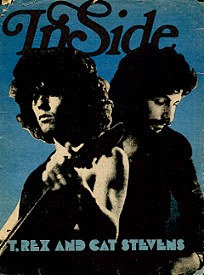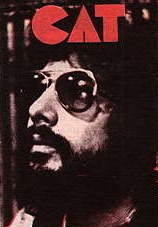Senior Scholastic, for those who have never heard of this
particular magazine . Senior
Scholastic was an educational magazine which was handed out to students in American High
Schools, through out the 1970's. I still remember the excitement of reading a Cat
Stevens article from a somewhat boring school magazine. He was featured at least 3 times
during the years 1972 - 1973.
This particular issue
featured the 'Two Top English Superstars' of 1972, Marc
Bolan and Cat Stevens, with an article written featuring each musician..
-
- Senior Scholastic
- March 27, 1972
- Courtesy of Bruce Lawrie
- ENGLISH SUPERSTAR
Written By Vernon Gibbs Cat Stevens doesn't jump around when he performs. He is a dark, slight,
shaggy-haired and visibly intense young man and he seems totally absorbed in the singing
and playing of his songs. When he slumps over his guitar in midsong, Stevens looks like a
sullen customer. But when he raises his head to look at the audience, everything changes.
His eyes aren’t the coal-hard circles you’d expect of a man of his
demeanor—they glow in a childlike, elfin innocence. It is this combination of
midnight intensity and daybreak openness that makes Cat Stevens special. Cat Stevens doesn't jump around when he performs. He is a dark, slight,
shaggy-haired and visibly intense young man and he seems totally absorbed in the singing
and playing of his songs. When he slumps over his guitar in midsong, Stevens looks like a
sullen customer. But when he raises his head to look at the audience, everything changes.
His eyes aren’t the coal-hard circles you’d expect of a man of his
demeanor—they glow in a childlike, elfin innocence. It is this combination of
midnight intensity and daybreak openness that makes Cat Stevens special.
Stevens’ rise
began—paradoxically—in a hospital. While still in his teens, Cat had begun what
seemed to be a promising career as a pop singer. He learned to play guitar in art school
by strumming along with American blues records. It wasn’t long before he was writing
and singing for a living. But after two bubbly, lavishly produced hits, "Matthew and
Son" and "I Love My Dog," Stevens was suddenly stricken with tuberculosis.
He was confined to a hospital for several months. When he finally recovered, he returned
to the scene of his earlier triumphs to find himself a forgotten man. A has-been at 19.
Not really. That prolonged
hospital stay had given Steve (Cat’s real name is Steven Demitri Georgiou, and his
friends call him Steve) time to think. He thought about his music, his career, and about
his life in general. He began to see beyond the shallow edge of reality. And when, still
hospitalized, he began to write songs again, they were different from before. These new
songs bore a fuller expression of interest in life; a more penetrating way of expressing
the sad parts. a more forceful way of questioning the destructive attitudes men carry with
them, dramatic sense of self-discovery, and a way of simply and boldly expressing
love.  Stevens called his
first post-recovery album Mona Bone Jakon. It contains many of the new-found elements of
his life "Lady D’Arbanville" expresses profound sadness at the
"death" of someone he once loved; In ‘Pop Star," Stevens comments
ironically on his former popularity by doing the song in the form of a talk with his
mother. "I Think I See the Light" expresses his discovery of an easier way of
getting along with people. Cat also likes to sing about magical places, and he does it in
a fanciful, faraway manner. "Katmandu" and
"Lilywhite" express distant visions that only he sees.
Stevens called his
first post-recovery album Mona Bone Jakon. It contains many of the new-found elements of
his life "Lady D’Arbanville" expresses profound sadness at the
"death" of someone he once loved; In ‘Pop Star," Stevens comments
ironically on his former popularity by doing the song in the form of a talk with his
mother. "I Think I See the Light" expresses his discovery of an easier way of
getting along with people. Cat also likes to sing about magical places, and he does it in
a fanciful, faraway manner. "Katmandu" and
"Lilywhite" express distant visions that only he sees.
The second album, Tea for
the Tillerman, was one of the finest surprises of the past year. On it, Stevens perfected
his soft lyrical approach, his brilliant songwriting: and his muscular yet sensitive
melodies. In other words, even though his songs are beautiful, they don’t droop. And
they show his Greek heritage.
Stevens has been compared
to James Taylor, but his words are more biting, his rhythms more infectious, his melodies
more beautiful, his guitar abilities more fiery-warm, and his vocal style more convincing.
Stevens identified himself very strongly on that album. There was never any question when
his songs come over the air. He had created a place for himself.
Songs like the angry
"Where Do The Children Play", living melodies that linger and haunt like those
on "Hard Headed Woman" and "Wild World", the sad understanding of
"Sad Lisa" and the resolution of "Miles From Nowhere" - they all
helped. Then there were the tasty slices of "But I Might Die Tonight"  and "Tea For The Tillerman", two songs
together less than three minutes long. And of course there were magical moments found on
things like "Into White" and Longer Boats." It made a complete and totally
enjoyable album, from first note to last. and "Tea For The Tillerman", two songs
together less than three minutes long. And of course there were magical moments found on
things like "Into White" and Longer Boats." It made a complete and totally
enjoyable album, from first note to last.
His latest album Teaser
and the Firecat, carries on the magic of the first two. There is the hopefullness of
"Peace Train", with it's classical guitar runs. The Forceful pleading of
"Bitterblue", the plaintive "If I Laugh", and "Moonshadow"
just a nice simple thought.
Teaser is another fine
effort from Cat Stevens and it indicates that he probably will be around for many years.
His piano playing and singing are in equally fine relationship to his always-arresting
songwriting and guitar work. His music is as pure as ever, and his elvlike nature is still
in very much evidence. Just as before, Cat Stevens has made music that is pleasant to
while remaining basic and vital.
Top of Page |